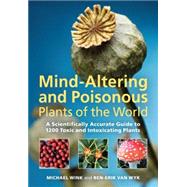
| Preface | p. 6 |
| Introduction | p. 7 |
| What are toxins and toxic plants? | p. 7 |
| What are mind-altering substances and psychoactive plants? | p. 10 |
| Why do poisons and mind-altering substances exist in nature? | p. 12 |
| Occurrence of toxins and mind-altering substances in nature | p. 14 |
| Poisonous and mind-altering plants in human history - murder, magic and medicine | p. 17 |
| Murder and Magic | p. 18 |
| Mind-altering plants of the Old World | p. 19 |
| Mind-altering plants of the New World | p. 22 |
| Early medicine | p. 24 |
| Importance of poisonous plants in modern life | p. 25 |
| Plants that affect the skin | p. 26 |
| Statistics of plant poisoning | p. 26 |
| Animal poisoning | p. 29 |
| First aid treatment | p. 30 |
| Diagnosis | p. 30 |
| Therapy | p. 32 |
| First aid - removal of toxins | p. 32 |
| Clinical therapy | p. 33 |
| Methods of testing for toxicity in humans | p. 35 |
| Information | p. 35 |
| Plants in alphabetical order | p. 36 |
| Structure of monographs | p. 37 |
| Toxins | p. 241 |
| How do poisons and mind-altering substances function? | p. 242 |
| Molecular modes of action | p. 242 |
| How do neurotoxins and mind-altering substances work? | p. 250 |
| Main classes of toxins and psychoactive compounds | p. 252 |
| Secondary metabolites with nitrogen | p. 252 |
| Aconitine, protoveratrine B and related terpene alkaloids | p. 252 |
| Bufotenin, tryptamines and tyramines | p. 255 |
| Caffeine and other purine alkaloids | p. 257 |
| Cytisine and related quinolizidine alkaloids | p. 258 |
| Colchicine and related alkaloids | p. 260 |
| Ephedrine, cathinone and mescaline | p. 262 |
| Ergot alkaloids | p. 263 |
| Hyoscyamine, cocaine and other tropane alkaloids | p. 265 |
| Indole alkaloids | p. 267 |
| Isoquinoline alkaloids | p. 270 |
| Lycopodium alkaloids | p. 274 |
| Lycorine and other Amaryllidaceae alkaloids | p. 275 |
| Morphine and other morphinane alkaloids | p. 277 |
| Pyrrolidine and piperidine alkaloids | p. 279 |
| Quinoline alkaloids | p. 281 |
| Senecionine and related pyrrolizidine alkaloids | p. 283 |
| Solanine and other steroid alkaloids | p. 285 |
| Amygdalin, other cyanogenic glucosides and HCN | p. 287 |
| Mustard oils/ glucosinolates | p. 289 |
| Non-protein amino acids (NPAAs) | p. 291 |
| Abrin, ricin other lectins and peptides | p. 294 |
| Secondary metabolites without nitrogen | p. 295 |
| Phenolics | |
| Flavonoids, isoflavones, alkyl phenols, tannins, lignans and other phenolics | p. 295 |
| Coumarins and furanocoumarins | p. 301 |
| Myristicin and other phenylpropanoids | p. 304 |
| Quinones | |
| Hydroquinones and naphthoquinones | p. 306 |
| Anthraquinones and naphthodianthrones | p. 308 |
| Polyacetylenes | p. 310 |
| Terpenoids | |
| Monoterpenes | p. 312 |
| Terpenes and phenylpropanoids with aldehyde groups | p. 315 |
| Sesquiterpenes and sesquiterpene lactones | p. 317 |
| Diterpenes: Phorbol ester | p. 320 |
| Andromedotoxin or grayanotoxin I | p. 322 |
| Steroids and triterpenes: Cardiac glycosides | p. 324 |
| Cucurbitacin E and related triterpenes | p. 327 |
| Saponins | p. 329 |
| Small reactive metabolites | |
| Ethanol | p. 332 |
| Oxalic acid, oxalates and other organic acids | p. 334 |
| Protoanemonin, tulipalin and parasorbic acid | p. 336 |
| Quick Guide to poisonous plants, mind-altering plants and fungi | p. 338 |
| Glossary | p. 420 |
| Further reading | p. 433 |
| Acknowledgements | p. 436 |
| Index | p. 437 |
| Table of Contents provided by Ingram. All Rights Reserved. |
The New copy of this book will include any supplemental materials advertised. Please check the title of the book to determine if it should include any access cards, study guides, lab manuals, CDs, etc.
The Used, Rental and eBook copies of this book are not guaranteed to include any supplemental materials. Typically, only the book itself is included. This is true even if the title states it includes any access cards, study guides, lab manuals, CDs, etc.